Kangra Fort Tour Which Is A Timeless Testament In Himachal Pradesh
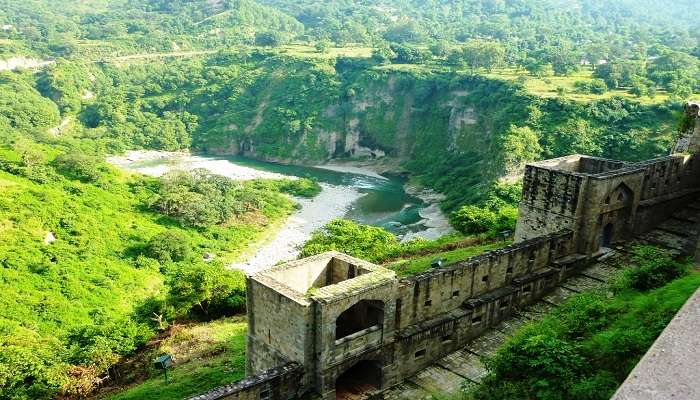
Perched majestically on a hillock between the Manjhi and Banganga rivers, Kangra Fort is a testament to ancient India’s rich history and architectural brilliance. This magnificent fort is often called ‘Nagarkot’ or ‘Kot Kangra’. This fort was constructed by the royal Rajput family of the Katoch dynasty, where it is not only the most giant fort in the Himalayas but also one of the oldest forts in India. Despite its age, Kangra Fort has been the theatre for many different historical events, from withstanding Mughal sieges to symbolising strength in the face of many invasions.
Origins And Historical Significance Of The Kangra Fort
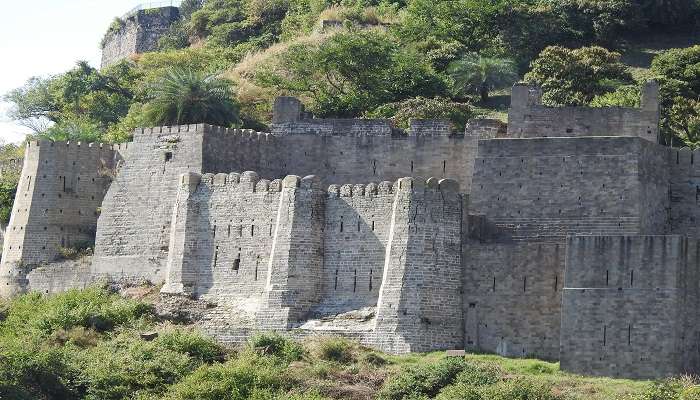
Kangra Fort was constructed by the Katoch Dynasty around 600 years ago. Here are some of the interesting facts about its history and other details:
-
The Katoch Dynasty And The Birth Of Kangra Fort
The historical foundation of the Kangra Fort can be pegged back to the early days of the Trigarta Kingdom, as mentioned in the recorded chronicle of Mahabharata. This fort was constructed by the Katoch dynasty, one of the oldest ruling families in the world, which makes it almost certain that the construction of the fort started as early as the 4th century BC. From this historical fort, the Katoch rulers saw their reigns of victories and defeats and lessons of the tides of time.
-
The Fort’s Role In Mughal Conquests
The geographical positioning of the Kangra Fort made it an important area that grabbed the attention of several invaders. It was subjected to a siege by Emperor Akbar in 1615. Nevertheless, it was Akbar’s son, Jahangir, who captured the fort in 1620, which is a historical story recorded in the history of this fort. Nonetheless, Mughal control was maintained over the fort despite the Katoch royalty’s various attempts to regain it until the Mughal Empire disintegrated in the late 18th Century.
-
The Era Of Raja Sansar Chand II
Losing their supremacy, the Mughals could not prevent Raja Sansar Chand II from regaining Kangra Fort in 1789. His reign also saw the British involved in wars with the Gurkhas and the Sikhs of the Sikh Empire. Though they tried to overthrow Sansar Chand with conspiracies and invasions, the treaty between Sansar Chand and Maharaja Ranjit Singh defeated the Gurkha army in 1809. The place was taken over after Sansar Chand’s death by Ranjit Singh in 1828.
-
British Occupation And The 1905 Earthquake
Kangra Fort was captured by the British after the first Anglo-Sikh war in 1846. It was still under British rule until the dreadful earthquake on April 4, 1905, hit it hard. Presently, it is a protected monument of the Archaeological Survey of India and is a symbol of strength and history.
Must Read: Places To Visit In Kangra
Architectural Marvels Details

Kangra Fort is famous for its unique architectural designs and tactful strategies. Here are some of the details regarding its architecture:
-
Strategic Location And Design
The architectural layout of Kangra Fort reveals the creators’ tactful planning and design. Nature has provided the fort with unassailable geographical advantages: It stands at the confluence of two rivers and has the Dhauladhar mountain range on all sides. Getting into the fort is not an easy task, as the entrance is fortified with gates and several courtyards, all designed to challenge an attacker and prevent him from reaching the main area of the fort.
-
The Gates Of Kangra Fort
The Kangra fort has 11 gates and 23 parapets or bastions, all of which have histories. Some of the well-known gates are the Ranjit Singh Gate, named after the Sikh king, and the Ahini, Jahangiri, and Andheri Gates. The greatness of the fort design can be seen in the Andheri Gate, otherwise called the Dark Gate, whose intention was to mislead and leave the intruder bewildered.
-
Temples And Religious Significance
There are a few temples inside the fort, which show its glory in religious aspects in that region. The temples referred to as Lakshmi Narayan Temple, Ambika Devi Temple, Lord Adinath Temple, and the Shitlamata Temple were constructed in the 9th and 10th centuries. These temples indeed portray the glorious and spiritual importance of Kangra Fort, but unfortunately, they are partly dilapidated due to the earthquake that hit the region in 1905.
Interiors Of Kangra Fort
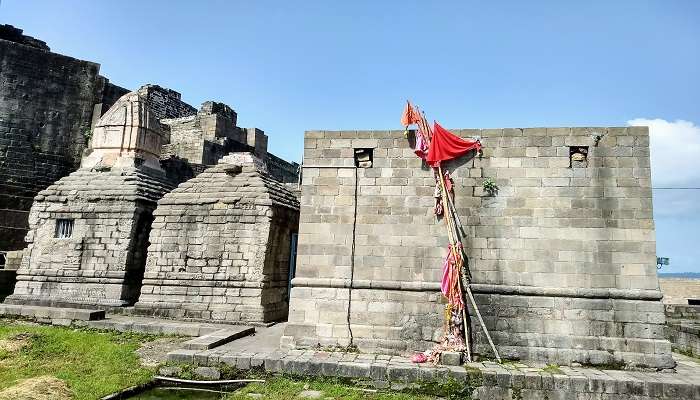
The interior of the fort is very wonderful. Here are some amazing details that you can figure out before paying a visit:
-
Royal Residences And Havelis
The interiors of Kangra Fort also offer a glimpse of the royal era of the Katoch dynasty’s kings and queens. Several palaces and havelis were constructed within the fort and used as residential complexes for the king and royalty. These structures have interior and exterior carvings and frescoes, which depict the architectural ingenuity and aesthetic sense of this age.
-
The Treasury And Armory
The fort’s treasury and armoury were important parts of its facilities. Originally, the treasury was a storage place for royal wealth, gold, and silver, as well as expensive stones and metals. The armoury, on the other hand, contained the arsenal depicting the military might of the Katoch rulers—weapons and armour galore. Both sections were well protected and placed strategically at appropriate positions within the fort for maximum security.
-
Audience Halls And Courtyards
In the region of Kangra Fort, there are several Audience halls and Courtyards where the king used to rule and used to sit for administrative works. Such spaces were intended to overwhelm the visitor with furniture’s architectural scale and grandeur. Such beautiful architectural designs can be seen at Darbar Hall, which has a high ceiling and the delicate work of pillars. The courtyards with the landscape and the fountains allowed the royal family and their guests to have a peaceful time.
-
Water Reservoirs And Storage Facilities
A fort needed to have and maintain a steady water source for the people living inside the fort to secure a fresh and clean water supply during an attack or a siege. The Kangra Fort has some clever architectural techniques regarding the water collection and storage system devised in its construction. These reservoirs were accessed through supply from natural springs and rainwater harvesting through dams, thus depicting the high level of engineering skills involved in the construction. Their main uses in the fort were for drinking, watering plants, and other uses such as washing etc., thereby ensuring the fort’s self-sufficiency
Suggested Read: Temples In Kangra
A Journey Through The Fort

Here are some of the wonderful details to explore about the Kangra Fort:
-
Exploring The Courtyards And Structures
First, when visitors approach Kangra Fort, they are welcomed by a large, multilevel, lush green courtyard with two old water tanks and ruins of the soldiers’ barracks. Starting from the gateway, there are various doors and courtyards on the way up, each of which provides an insight into the fort’s history.
-
The Museum Of Kangra Fort
The Monument itself has numerous rare antiquities, such as statues, coins, and weapons, preserved at the Kangra Fort Museum. These are very important in that they give a historical view of the culture’s growth and development of the dynasties that dominated the valley. This museum has especially preserved Pahari miniature paintings, and the art of the Mughal and Sikh regimes can be clearly seen here.
-
The Panoramic Views
Kangra Fort is strategically located, perched high to offer splendid vistas of the Kangra Valley and the distant Dhauladhar peaks. The natural and historical background of Kangra Fort contributes a lot to the exotic visit one gets to have when at the site.
The Fort Today: Preservation And Conservation Efforts
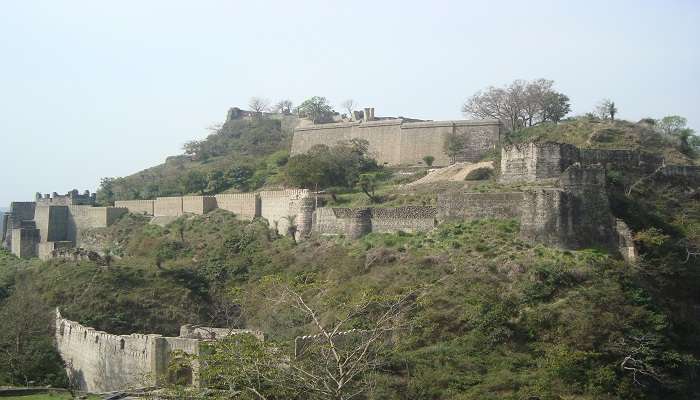
Before visiting this iconic monument, here are some details regarding its preservation and conservation that are worth exploring:
-
Restoration Initiatives
Several structural interventions by the Archaeological Survey of India (ASI) have been taken to retain the structural beauty of Kangra Fort. All these measures are directed towards preserving the structural integrity of the fort and preventing further deterioration of this historical treasure. ASI and the local authorities have ensured and will continue to ensure that the fabric of the fort is preserved and passed on to future generations with as much authenticity as possible.
-
Community Involvement
Protection measures also involve the inhabitants of the surrounding territory, who bear great responsibility for conserving the fortification’s history. Community engagement and educational programs are pivotal in creating awareness regarding conserving this cultural structure.
Suggested Read: Things To Do In Kangra
How To Reach Kangra Fort
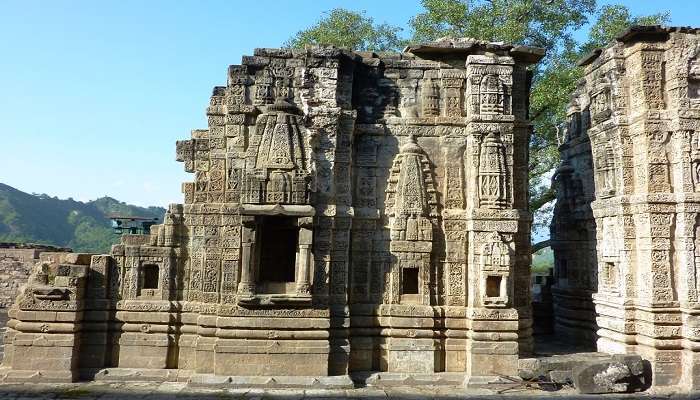
If you are visiting this wonderful building for the first time, here are the details on how to reach it without any hassle:
By Air
The closest airport to Kangra Fort is Gaggal Airport, which is around 14 kilometers from the Kangra Valley. This airport is particularly connected to Delhi, as there are many flights available.
By Train
The nearest broad gauge railway station is Pathankot Cantt (Chakki), which is only about 87 km away from Kangra. Many prefer the narrow gauge, and in this case, the nearest station is Kangra Mandir railway station. From these stations, one can order a taxi or take a direct bus to the fort.
By Road
Kangra is fairly well-connected by road and is 471 kilometres away from New Delhi. Volvo buses drop you at Kangra Fort if you have chosen one that takes an overnight journey. Otherwise, a taxi can be hired directly.
Further Read: Snowfall In Kangra
A trip to Himachal Pradesh perfectly blends natural beauty and historical grandeur. Kangra Fort, nestled amidst the great snowy lap of the Himalayas, stands as a symbol of the glory of bygone kingdoms. Discover the ancient tales of its construction and the wonderful historical legacy that is carefully kept there. Kangra Fort is well connected by air, rail, and road, and its exploration is a unique and adventurous journey for history enthusiasts. Furthermore, one shouldn’t miss the breathtaking bird’s eye view of Kangra valley and the snow-covered Dhauladhar range.
For our editorial codes of conduct and copyright disclaimer, please click here.
Cover Image Credit: John Hill for Wikimedia Commons
Frequently Asked Questions About The Kangra Fort
Why is the Kangra Fort a famous tourist destination?
Kangra Fort is famous for its architecture and panoramic view. Also, it is one of the oldest forts in India. Kangra Fort unfolds many historical events and stands as one of the most famous tourist destinations in Himachal Pradesh.
Who built the Kangra Fort?
The Kangra Fort was built by the rulers of the Katoch Dynasty as early as the 4th century BC. Since then, this majestic fort has witnessed the Mughal conquests, the reign of Raja Sansar Chand II, British occupation, and the 1905 Earthquake.
How to reach Kangra Fort?
Kangra Fort is well-connected, and one can reach the fort by bus, train or flight. The nearest airport is Gaggal Airport, and the nearest station is Pathankot. Kangra Fort is 471 kilometres from Delhi, from where you can take a bus or hire a taxi to Kangra Fort.
What view can we find at the top of the Kangra Fort?
The Kangra Fort presents breathtaking views of the lush Kangra Valley and the picturesque Dhauladhar Ranges. Its historical background and stupendous views make it one of the most visited tourist destinations.
Can I click pictures inside Kangra Fort?
Certainly! Carry your cameras and capture the essence of Indian History when you visit the Kangra Fort. Clicking pictures inside the Fort is allowed but not inside the museum. You can also carry binoculars to view the Dhauladhar Ranges and the Kangra Valley closely.
People Also Read:
Red Fort Neemrana Fort Mehrangarh Fort

Get ready to wander the world through amazing visual tours that we provide via our blogs and stories. As a content writer, I love sharing incredible travel experiences that inspire readers to plan their own adventures and create unforgettable memories. From planning to execution, everything has already been served in these amusing tales. Let’s explore the world together, one destination at a time!











